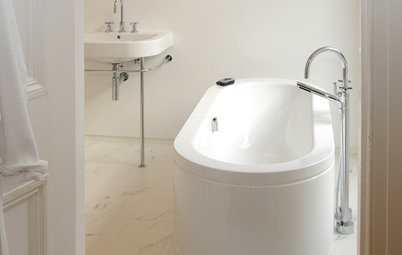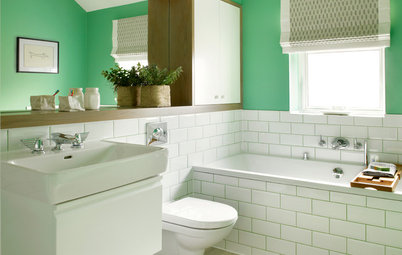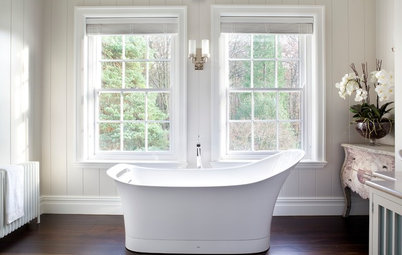What Are the Best Ways to Light My Bathroom?
Four experts shine a light on how to get your bathroom lighting right first time
Light is often limited in bathrooms because windows tend to be small – or even non-existent. When compensating for this, it’s important not simply to light the room but to enhance it. “Don’t be afraid to play up the lighting to counterbalance the lack of natural light,” advises Phillip Pini at Crestron. Be sure to position light sources intelligently too: every fixture should have a purpose.
But how can you know what’s right for your space? Would simple ceiling lights providing overall illumination be best, or would downlights make more of an impact? What you choose and where you position it can be confusing. So as part of our Bathroom Planning guide, read on for tops tips from a panel of experts.
Professional advice from Ben Rousseau of Rousseau Design; James Bassant of Astro Lighting; Phillip Pini at Crestron; Sally Storey of John Cullen Lighting
Starting your bathroom project? Read How to Plan for a Bathroom Renovation
But how can you know what’s right for your space? Would simple ceiling lights providing overall illumination be best, or would downlights make more of an impact? What you choose and where you position it can be confusing. So as part of our Bathroom Planning guide, read on for tops tips from a panel of experts.
Professional advice from Ben Rousseau of Rousseau Design; James Bassant of Astro Lighting; Phillip Pini at Crestron; Sally Storey of John Cullen Lighting
Starting your bathroom project? Read How to Plan for a Bathroom Renovation
2. Plan ahead
Think about bathroom lighting at the start of your project and, if possible, chat through your options with a qualified lighting designer and installer.
Phillip Pini at Crestron explains why: “By deciding where you need the lights to be at an early stage, you can plan where you will need to install required cabling, and budget for an appropriate number of fittings and the control options you desire. The type of lighting you want in the room will also need to be taken into consideration, as this has a dramatic impact on the look and feel of the space.”
Think about bathroom lighting at the start of your project and, if possible, chat through your options with a qualified lighting designer and installer.
Phillip Pini at Crestron explains why: “By deciding where you need the lights to be at an early stage, you can plan where you will need to install required cabling, and budget for an appropriate number of fittings and the control options you desire. The type of lighting you want in the room will also need to be taken into consideration, as this has a dramatic impact on the look and feel of the space.”
3. Use layers of light
Multiple layers of light from a variety of sources are the secret to a successful bathroom lighting scheme. In much the same way that an interior designer uses colour and texture to enhance the look of a room, lighting designers work with ambient, task and accent lighting to create a space that is practical but also could, if it’s the look you’re after, have a relaxing, spa-like quality.
More: 11 Interesting Ways to Illuminate Your Bathroom
Multiple layers of light from a variety of sources are the secret to a successful bathroom lighting scheme. In much the same way that an interior designer uses colour and texture to enhance the look of a room, lighting designers work with ambient, task and accent lighting to create a space that is practical but also could, if it’s the look you’re after, have a relaxing, spa-like quality.
More: 11 Interesting Ways to Illuminate Your Bathroom
4. Include ambient lighting
Ambient lighting, sometimes known as general lighting, provides overall illumination, allowing you to see and walk about the bathroom safely. Downlights are a practical consideration for general light, but avoid laying them out in a regular grid formation. Instead, think about where lighting is needed most and why.
“Highlight finishes by locating a directional LED downlight close to a tiled or stone wall, creating streaks of light almost like running water,” recommends Sally. “Position another to direct light towards the basin, and one above the WC or towel rail to provide the perfect balance.”
In bathrooms with ceilings over three metres, consider a statement chandelier to provide focus and give the impression of a lower ceiling height. “Use other light sources so you don’t have to rely on the chandelier’s light, as it won’t provide the right mood for every occasion,” warns James Bassant at Astro. “And remember, it must be IP rated for its location.”
Ambient lighting, sometimes known as general lighting, provides overall illumination, allowing you to see and walk about the bathroom safely. Downlights are a practical consideration for general light, but avoid laying them out in a regular grid formation. Instead, think about where lighting is needed most and why.
“Highlight finishes by locating a directional LED downlight close to a tiled or stone wall, creating streaks of light almost like running water,” recommends Sally. “Position another to direct light towards the basin, and one above the WC or towel rail to provide the perfect balance.”
In bathrooms with ceilings over three metres, consider a statement chandelier to provide focus and give the impression of a lower ceiling height. “Use other light sources so you don’t have to rely on the chandelier’s light, as it won’t provide the right mood for every occasion,” warns James Bassant at Astro. “And remember, it must be IP rated for its location.”
5. Tackle task lighting
You need a different kind of light – task lighting – for fine-detail activities such as putting on make-up or shaving.
Use multiple layers of light around bathroom mirrors to avoid unflattering shadows on faces. “Too much light overhead and you will have shadows under the eyes; too much face-facing light and the experience is uncomfortable,” explains Ben Rousseau of Rousseau Design.
“For a bigger bathroom, I would recommend backlighting a mirror with an LED strip as this gives wow factor and adds more glamour to the space,” suggests Storey.
If your bathroom is too modern or small for wall lights, a mirror with integrated lighting works just as well, particularly in a small cloakroom.
More: 10 Gorgeous Ways to Light Your Bathroom Vanity Mirror
You need a different kind of light – task lighting – for fine-detail activities such as putting on make-up or shaving.
Use multiple layers of light around bathroom mirrors to avoid unflattering shadows on faces. “Too much light overhead and you will have shadows under the eyes; too much face-facing light and the experience is uncomfortable,” explains Ben Rousseau of Rousseau Design.
“For a bigger bathroom, I would recommend backlighting a mirror with an LED strip as this gives wow factor and adds more glamour to the space,” suggests Storey.
If your bathroom is too modern or small for wall lights, a mirror with integrated lighting works just as well, particularly in a small cloakroom.
More: 10 Gorgeous Ways to Light Your Bathroom Vanity Mirror
Alternatively, a winning combination is a ceiling-mounted fixture teamed with side lights positioned either side of a mirror. Make sure the overhead light is centred over the basin, but set in line with its front edge to avoid shadowing. If you have a large mirror, consider installing two fixtures set 60 to 80cm apart to cross-light your face.
6. Don’t forget the shower
The number one rule when lighting your shower enclosure is not to centre a light overhead: the effect is unflattering. Instead, consider clever tricks such as washing light down the back wall of the shower to draw attention to the colour and texture of tiles or marbling. This will extend the feeling of the space, too.
More: What Do I Need to Know When Choosing a Shower Enclosure?
The number one rule when lighting your shower enclosure is not to centre a light overhead: the effect is unflattering. Instead, consider clever tricks such as washing light down the back wall of the shower to draw attention to the colour and texture of tiles or marbling. This will extend the feeling of the space, too.
More: What Do I Need to Know When Choosing a Shower Enclosure?
7. Add some spa quality
Accent lighting can help create a spa-like feel in the bathroom. “It helps you relax and sets the tone for winding down, or getting ready to dress up,” explains Rousseau.
Accent lighting can help create a spa-like feel in the bathroom. “It helps you relax and sets the tone for winding down, or getting ready to dress up,” explains Rousseau.
Downlight wall niches or install a series of low-level lights at skirting level, and hide a light source under a wall-mounted vanity to make it look instantly lighter.
“For that magical spa quality, it is the 1w low-level LED that makes the difference,” says Sally, who suggests using 1w uplights to illuminate a stone or tiled wall behind a freestanding bath.
Look at uplights set into a windowsill to light shutters too. “This effect is almost like putting night lights around – it is the instant candle,” adds Storey
“For that magical spa quality, it is the 1w low-level LED that makes the difference,” says Sally, who suggests using 1w uplights to illuminate a stone or tiled wall behind a freestanding bath.
Look at uplights set into a windowsill to light shutters too. “This effect is almost like putting night lights around – it is the instant candle,” adds Storey
8. Take control
Planning how you are going to control bathroom lights is just as important as knowing where you want to locate them and what sort of effect you want them to produce. One option is to have two lighting circuits so you can control practical lighting and accent lighting separately.
The best solution, however, is a lighting system controlled by a touchscreen panel. You can then pre-programme a variety of settings to meet your needs and preferences. “Lighting scenes can be programmed to cover everything from first thing in the morning with lights gradually illuminating to a daytime level, to an evening scene with certain lights being dimmed to create a peaceful ambience to relax and unwind in,” explains Phillip. “By using lighting controls alongside LED, you can reduce the amount of energy that is wasted by lighting unoccupied spaces.”
Planning how you are going to control bathroom lights is just as important as knowing where you want to locate them and what sort of effect you want them to produce. One option is to have two lighting circuits so you can control practical lighting and accent lighting separately.
The best solution, however, is a lighting system controlled by a touchscreen panel. You can then pre-programme a variety of settings to meet your needs and preferences. “Lighting scenes can be programmed to cover everything from first thing in the morning with lights gradually illuminating to a daytime level, to an evening scene with certain lights being dimmed to create a peaceful ambience to relax and unwind in,” explains Phillip. “By using lighting controls alongside LED, you can reduce the amount of energy that is wasted by lighting unoccupied spaces.”
9. Get help
Still confused? Look for a lighting designer who can advise on your space. He or she will be well versed in which lights to use where and how to control them to achieve the best results. It is especially important to hire a qualified electrician to carry out the work.
Tell us…
What kind of bathroom lighting do you like – and what tips can you share? Let us know in the Comments below.
Still confused? Look for a lighting designer who can advise on your space. He or she will be well versed in which lights to use where and how to control them to achieve the best results. It is especially important to hire a qualified electrician to carry out the work.
Tell us…
What kind of bathroom lighting do you like – and what tips can you share? Let us know in the Comments below.






















It goes without saying that all fixtures for the bathroom must be waterproof. This is measured by the ingress protection (IP) rating, which defines the level at which the fitting is sealed against dirt and moisture.
Strict electrical safety regulations govern what level of IP rating can be used where in the bathroom. Sally Storey of John Cullen Lighting explains: “Zone 0 is the area inside the bath or the shower basin and only fully submersible products that are IP67 can be used here. Zone 1, the area immediately above the bath or shower, requires IP65 fittings. Zone 2 is the area stretching 0.6m outside the perimeter of the bath and basin, plus to a height of 2.25m from the floor around the bath. Fittings here need to have a rating of at least IP44.”
Find and hire a professional lighting installer in your area and read reviews from previous clients.